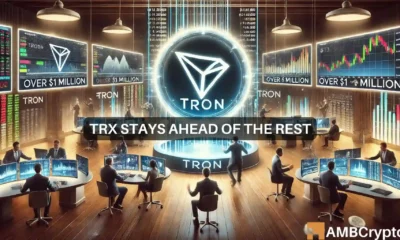Altcoin
USDT YoY dominance grows since last capitulation, leaves other stablecoins trailing
The third-largest asset in market cap has maintained its lead in stablecoin adoption. Notwithstanding happenings on host blockchains differed.
- User confidence in adopting USDT for trade has surpassed its competition.
- There is enough stablecoin purchasing power to buy BTC, but Ethereum’s supremacy blooms.
Tether [USDT] has solidified its position as the most popular stablecoin among cryptocurrency users and traders. Although there were doubts about the sustainability of this group of assets when the TerraUSD [UST], the dollar-pegged stablecoin of the Terra blockchain collapsed, USDT displayed resilience to weather the storm.
How much are 1,10,100 USDTs worth today?
No rivalry, only command
One year after the incident, the third-largest cryptocurrency in market capitalization, added another 20% dominance, Glassnode revealed.
Following the LUNA collapse, USDT has grown its relative #Stablecoin market share by 20% whilst USDC, BUSD and DAI have seen meaningful drops in dominance.
? USDT Dominance: 65.9% (+20%)
? USDC Dominance: 24% (-13%)
? BUSD Dominance: 4.6% (-7.2%)
? DAI Dominance: 3.9%… pic.twitter.com/jT69zQiQxL— glassnode (@glassnode) May 12, 2023
From the tweet above, this growth has ensured that the overall lead has extended to a 65.9% market share. Circle [USDC] emerged second, but its Year-on-Year (YoY) ascendancy decreased by 13%. As anticipated, the order to stop the issuance of Binance USD [BUSD] affected its share. And this had helped the adoption of TrueUSD [TUSD].
Furthermore, USDT’s growth has set it apart from the competition with a widening gap in terms of circulating supply and market presence. At the time of writing, on-chain data showed that the asset accounted for $82.38 billion out of the possible $125 billion in broader stablecoin circulation.
Therefore, it was not surprising that Tether posted an incredibly profitable first quarter (Q1) since no other stablecoin was actively available for trade like USDT. However, it has not been an entire walkover for the stablecoin market when compared with Bitcoin [BTC] and Ethereum [ETH].
Trials against the big two
At press time, the Bitcoin Stablecoin Supply Ratio (SSR) was low at 4.08. The metric serves as a measure of the supply and demand dynamics between dollar-backed assets and BTC.
When the SSR is high, it means that the current stablecoin supply does not have the buying power to purchase BTC. But since the average buying power was less than average, it implied that there was enough stablecoin supply to attend to BTC’s demand.
With respect to Ethereum, the top five stablecoins were not exactly commanding. In comparing the dominance here, on-chain data considers the Ethereum market capitalization and aggregate stablecoin market value.
Realistic or not, here’s TUSD’s market cap in USDT terms
Market capitalization refers to the multiplication of an asset price by the maximum supply, whether circulating, locked, or burned. Needless to say, it is important to track this metric especially as stablecoins have other blockchains as their host.
As of this writing, Ethereum’s market cap was well over $215 billion. The top stablecoins, on the other hand, had a market cap of $125 billion. This means that Ethereum dominated, leaving the stablecoin dominance in the negative.
